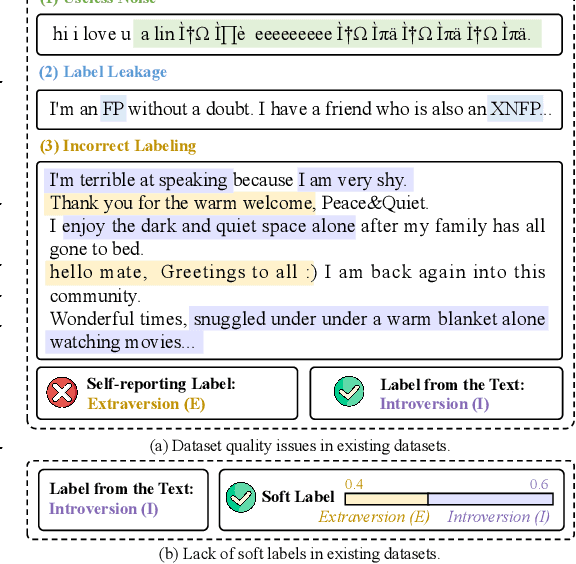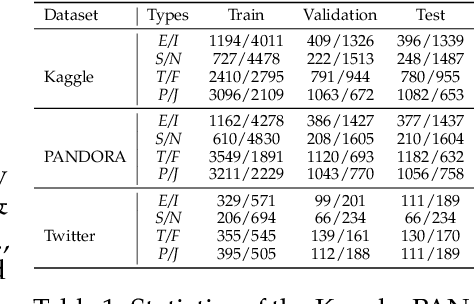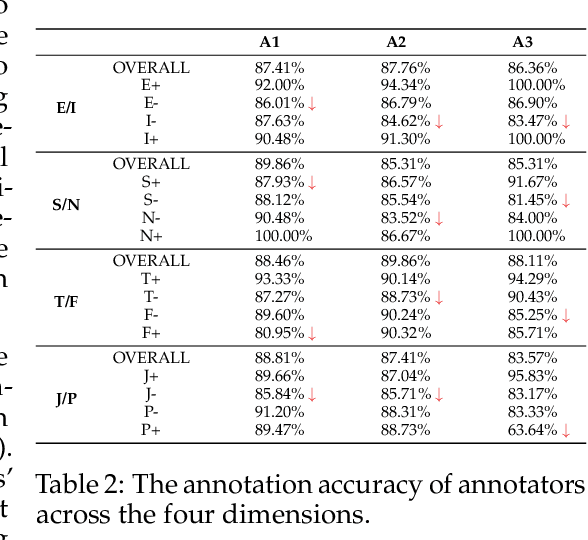Qingfu Zhu
Tag-Evol: Achieving Efficient Instruction Evolving via Tag Injection
May 30, 2025Abstract:Evol-Instruct has made significant improvements as a data synthesis method in several areas. Existing methods typically rely on a fixed set of strategies to evolve, which require manual design and are monolithic in form. In addition, iterative evolution also makes the acquisition of hard samples expensive. In view of this, we propose the Tag-Evol framework, a more diverse and efficient instruction evolving method. Specifically, Tag-Evol uses diverse and specific knowledge tags as strategies to achieve controlled evolution by injecting different combinations of tags into the original instructions. Experiments with multiple backbones in diverse domain benchmarks show that the proposed method generates significantly better evolved data than other methods. Furthermore, we conduct a thorough analysis of the evolved data, demonstrating that Tag-Evol is not only efficient but also generates more diverse and challenging data.
Lookahead Q-Cache: Achieving More Consistent KV Cache Eviction via Pseudo Query
May 24, 2025Abstract:Large language models (LLMs) rely on key-value cache (KV cache) to accelerate decoding by reducing redundant computations. However, the KV cache memory usage grows substantially with longer text sequences, posing challenges for efficient deployment. Existing KV cache eviction methods prune tokens using prefilling-stage attention scores, causing inconsistency with actual inference queries, especially under tight memory budgets. In this paper, we propose Lookahead Q-Cache (LAQ), a novel eviction framework that generates low-cost pseudo lookahead queries to better approximate the true decoding-stage queries. By using these lookahead queries as the observation window for importance estimation, LAQ achieves more consistent and accurate KV cache eviction aligned with real inference scenarios. Experimental results on LongBench and Needle-in-a-Haystack benchmarks show that LAQ outperforms existing methods across various budget levels, achieving a 1 $\sim$ 4 point improvement on LongBench under limited cache budget. Moreover, LAQ is complementary to existing approaches and can be flexibly combined to yield further improvements.
Think Before You Accept: Semantic Reflective Verification for Faster Speculative Decoding
May 24, 2025Abstract:Large language models (LLMs) suffer from high inference latency due to the auto-regressive decoding process. Speculative decoding accelerates inference by generating multiple draft tokens using a lightweight model and verifying them in parallel. However, existing verification methods rely heavily on distributional consistency while overlooking semantic correctness, thereby limiting the potential speedup of speculative decoding. While some methods employ additional models for relaxed verification of draft tokens, they often fail to generalize effectively to more diverse or open-domain settings. In this work, we propose Reflective Verification, a training-free and semantics-aware approach that achieves a better trade-off between correctness and efficiency. Specifically, we leverage the inherent reflective capacity of LLMs to semantically assess the correctness of draft tokens in parallel during verification. Using prompt-based probing, we obtain both the original and reflective distributions of draft tokens in a single forward pass. The fusion of these distributions enables semantic-level verification of draft tokens that incorporates both consistency and correctness. Experiments across multiple domain benchmarks and model scales demonstrate that our method significantly increases the acceptance length of draft tokens without compromising model performance. Furthermore, we find that the proposed Reflective Verification is orthogonal to existing statistical verification methods, and their combination yields additional 5$\sim$15\% improvements in decoding speed.
RoT: Enhancing Table Reasoning with Iterative Row-Wise Traversals
May 21, 2025Abstract:The table reasoning task, crucial for efficient data acquisition, aims to answer questions based on the given table. Recently, reasoning large language models (RLLMs) with Long Chain-of-Thought (Long CoT) significantly enhance reasoning capabilities, leading to brilliant performance on table reasoning. However, Long CoT suffers from high cost for training and exhibits low reliability due to table content hallucinations. Therefore, we propose Row-of-Thought (RoT), which performs iteratively row-wise table traversal, allowing for reasoning extension and reflection-based refinement at each traversal. Scaling reasoning length by row-wise traversal and leveraging reflection capabilities of LLMs, RoT is training-free. The sequential traversal encourages greater attention to the table, thus reducing hallucinations. Experiments show that RoT, using non-reasoning models, outperforms RLLMs by an average of 4.3%, and achieves state-of-the-art results on WikiTableQuestions and TableBench with comparable models, proving its effectiveness. Also, RoT outperforms Long CoT with fewer reasoning tokens, indicating higher efficiency.
Success is in the Details: Evaluate and Enhance Details Sensitivity of Code LLMs through Counterfactuals
May 20, 2025Abstract:Code Sensitivity refers to the ability of Code LLMs to recognize and respond to details changes in problem descriptions. While current code benchmarks and instruction data focus on difficulty and diversity, sensitivity is overlooked. We first introduce the CTF-Code benchmark, constructed using counterfactual perturbations, minimizing input changes while maximizing output changes. The evaluation shows that many LLMs have a more than 10\% performance drop compared to the original problems. To fully utilize sensitivity, CTF-Instruct, an incremental instruction fine-tuning framework, extends on existing data and uses a selection mechanism to meet the three dimensions of difficulty, diversity, and sensitivity. Experiments show that LLMs fine-tuned with CTF-Instruct data achieve over a 2\% improvement on CTF-Code, and more than a 10\% performance boost on LiveCodeBench, validating the feasibility of enhancing LLMs' sensitivity to improve performance.
Is Compression Really Linear with Code Intelligence?
May 16, 2025Abstract:Understanding the relationship between data compression and the capabilities of Large Language Models (LLMs) is crucial, especially in specialized domains like code intelligence. Prior work posited a linear relationship between compression and general intelligence. However, it overlooked the multifaceted nature of code that encompasses diverse programming languages and tasks, and struggled with fair evaluation of modern Code LLMs. We address this by evaluating a diverse array of open-source Code LLMs on comprehensive multi-language, multi-task code benchmarks. To address the challenge of efficient and fair evaluation of pre-trained LLMs' code intelligence, we introduce \textit{Format Annealing}, a lightweight, transparent training methodology designed to assess the intrinsic capabilities of these pre-trained models equitably. Compression efficacy, measured as bits-per-character (BPC), is determined using a novel, large-scale, and previously unseen code validation set derived from GitHub. Our empirical results reveal a fundamental logarithmic relationship between measured code intelligence and BPC. This finding refines prior hypotheses of linearity, which we suggest are likely observations of the logarithmic curve's tail under specific, limited conditions. Our work provides a more nuanced understanding of compression's role in developing code intelligence and contributes a robust evaluation framework in the code domain.
Abacus-SQL: A Text-to-SQL System Empowering Cross-Domain and Open-Domain Database Retrieval
Apr 14, 2025Abstract:The existing text-to-SQL systems have made significant progress in SQL query generation, but they still face numerous challenges. Existing systems often lack retrieval capabilities for open-domain databases, requiring users to manually filter relevant databases. Additionally, their cross-domain transferability is limited, making it challenging to accommodate diverse query requirements. To address these issues, we propose Abacus-SQL. Abacus-SQL utilizes database retrieval technology to accurately locate the required databases in an open-domain database environment. It also enhances the system cross-domain transfer ability through data augmentation methods. Moreover, Abacus-SQL employs Pre-SQL and Self-debug methods, thereby enhancing the accuracy of SQL queries. Experimental results demonstrate that Abacus-SQL performs excellently in multi-turn text-to-SQL tasks, effectively validating the approach's effectiveness. Abacus-SQL is publicly accessible at https://huozi.8wss.com/abacus-sql/.
A Survey on Transformer Context Extension: Approaches and Evaluation
Mar 17, 2025Abstract:Large language models (LLMs) based on Transformer have been widely applied in the filed of natural language processing (NLP), demonstrating strong performance, particularly in handling short text tasks. However, when it comes to long context scenarios, the performance of LLMs degrades due to some challenges. To alleviate this phenomenon, there is a number of work proposed recently. In this survey, we first list the challenges of applying pre-trained LLMs to process long contexts. Then systematically review the approaches related to long context and propose our taxonomy categorizing them into four main types: positional encoding, context compression, retrieval augmented, and attention pattern. In addition to the approaches, we focus on the evaluation of long context, organizing relevant data, tasks, and metrics based on existing long context benchmarks. Finally, we summarize unresolved issues in the long context domain and put forward our views on future developments.
MULTITAT: Benchmarking Multilingual Table-and-Text Question Answering
Feb 24, 2025Abstract:Question answering on the hybrid context of tables and text (TATQA) is a critical task, with broad applications in data-intensive domains. However, existing TATQA datasets are limited to English, leading to several drawbacks: (i) They overlook the challenges of multilingual TAT-QA and cannot assess model performance in the multilingual setting. (ii) They do not reflect real-world scenarios where tables and texts frequently appear in non-English languages. To address the limitations, we propose the first multilingual TATQA dataset (MULTITAT). Specifically, we sample data from 3 mainstream TATQA datasets and translate it into 10 diverse languages. To align the model TATQA capabilities in English with other languages, we develop a baseline, Ours. Experimental results reveal that the performance on non-English data in MULTITAT drops by an average of 19.4% compared to English, proving the necessity of MULTITAT. We further analyze the reasons for this performance gap. Furthermore, Ours outperforms other baselines by an average of 3.3, demonstrating its effectiveness.
Can Large Language Models Understand You Better? An MBTI Personality Detection Dataset Aligned with Population Traits
Dec 17, 2024



Abstract:The Myers-Briggs Type Indicator (MBTI) is one of the most influential personality theories reflecting individual differences in thinking, feeling, and behaving. MBTI personality detection has garnered considerable research interest and has evolved significantly over the years. However, this task tends to be overly optimistic, as it currently does not align well with the natural distribution of population personality traits. Specifically, (1) the self-reported labels in existing datasets result in incorrect labeling issues, and (2) the hard labels fail to capture the full range of population personality distributions. In this paper, we optimize the task by constructing MBTIBench, the first manually annotated high-quality MBTI personality detection dataset with soft labels, under the guidance of psychologists. As for the first challenge, MBTIBench effectively solves the incorrect labeling issues, which account for 29.58% of the data. As for the second challenge, we estimate soft labels by deriving the polarity tendency of samples. The obtained soft labels confirm that there are more people with non-extreme personality traits. Experimental results not only highlight the polarized predictions and biases in LLMs as key directions for future research, but also confirm that soft labels can provide more benefits to other psychological tasks than hard labels. The code and data are available at https://github.com/Personality-NLP/MbtiBench.
 Add to Chrome
Add to Chrome Add to Firefox
Add to Firefox Add to Edge
Add to Edge